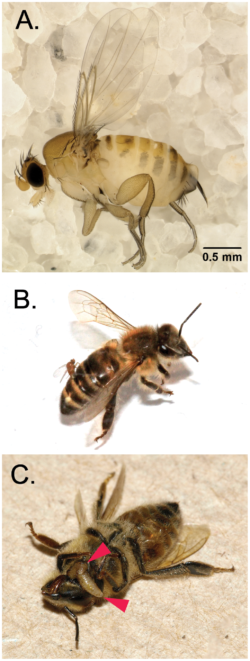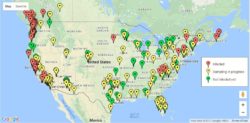Flight of the Living Dead
Posted on Categories Discover Magazine

By: Ayla Fudala
If you’ve ever seen bees flying around at night, there’s a good chance they’re so-called “ZomBees”—honey bees whose brains are under the control of tiny fly larvae growing inside their bodies.
Yes, you read that correctly.
Get up close and personal with Zombie flies and ZomBees. Image A shows an adult Zombie fly. Image B shows the Zombie fly laying eggs in a honey bee’s abdomen. Note the size difference between the two insects. Image C shows the Zombie fly larvae emerging from a dead honey bee’s abdomen. Credit: http://journals.plos.org/plosone/article?id=10.1371/journal.pone.0029639
It sounds like something straight out of a Hollywood B-movie: ZomBees are honey bees which have been parisitized by so-called “zombie” flies, (Apocephalus borealis). These tiny flies lay their eggs in the abdomen of helpless bees. Then the eggs hatch and eat the bee from the inside, killing it in the process. About 7 days after the bee has died, up to 13 zombie fly larvae emerge from its neck, decapitating the bee. Then the larvae pupate and hatch 28 days later as fully grown zombie flies.
This chilling occurrence was discovered by San Francisco State University Professor John Hafernik while he was collecting dead bees to feed his pet praying mantis. He forgot a few bees in a test tube for a couple of weeks, and was shocked when he discovered that something had hatched from their bodies.
Hafernik and his students, concerned by the addition of a new threat to the already struggling honey bee, began studies on the zombie flies and infected bees. They found that the flies, which were known to parasitize bumble bees and paper wasps, were now targeting honey bees as well.
Their research showed that seventy-seven percent of sites sampled in the San Francisco Bay Area were infected. Could this be happening to honey bees all across North America? To find out, Hafernik and his colleagues launched the ZomBee Watch Citizen Science program, which teaches ordinary citizens how to collect ZomBee samples and report their findings online.
This ambitious and far-reaching program was ranked in SciStarter’s top 10 Citizen Science programs of 2015. Samples have been reported all over the United States, from Hawaii to Massachusetts, and even from Canada! Citizen scientists have made important discoveries and extended the range of zombie fly parasitism of honey bees to the Pacific Northwest, the eastern US, the eastern US, the southern US, and both western and eastern Canada.

Locations of ZomBee samples collected across North America by citizen scientists. Source: https://www.zombeewatch.org/map/public#.WHkv3fkrLIU
When Planet Bee Foundation learned of this threat to our favorite insect, we knew that we had to do something. Planet Bee is a San Francisco-based educational nonprofit on a mission to save the world – one bee and one student at a time. We teach lessons on bee biology and behavior, pollination, Colony Collapse Disorder, beekeeping, and honey harvesting at schools, nonprofits, and businesses throughout northern California. Our goal is to create a green-minded generation of environmental stewards using the teaching lens of the struggling honey bee and the power of individual action. Planet Bee teamed up with Professor Hafernik and SF State University’s Biology department to create our own hands-on lesson on how to catch and study ZomBees.

Students at Oak Grove Elmentary and Argonne Elementary build ZomBee Light Traps with help from Planet Bee Educators. Source: Planet Bee Foundation
Through our ZomBee Watch K-12 School Program (ZBW), Planet Bee educators visit schools and teach students how to become ZomBee Hunters! In this three-day program, students learn the basic biology of ZomBees, design, build and deploy their own ZomBee light traps, and examine the contents of their traps to determine whether they have caught any ZomBees. Students post their findings on the official ZomBee Watch website; thus contributing to real scientific research on the geographical spread of the zombie fly. Teachers at Bay Area schools interested in bringing ZBW to their students can sign up here.
Planet Bee has enjoyed working with Bay Area schools such as Oak Grove Elementary and Argonne Elementary, and is looking forward to piloting our national remote ZBW program with students at Sandwich Middle School in Massachusetts this spring.. As we tell our students at the end of each class, please take a little time out of your day to ask, “What can I do to help the bees?” Would you like to help the bees? We would love to hear from you!
Guest post written by Ayla Fudala, Planet Bee Educator and Staff Writer
Planet Bee Foundation will begin offering ZBW to out-of-state schools in the fall of 2017. If you’re a teacher at a school outside of northern California and you’re interested in signing up for our national remote program, please email the team at programs@planetbee.org. Want more citizen science? Check out SciStarter’s Project Finder! With 1100+ citizen science projects spanning every field of research, task and age group, there’s something for everyone!